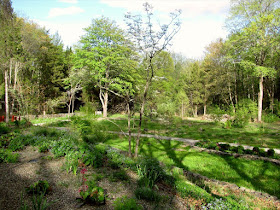The entrance, echos of the jungle, impressive trees, a planting with impatiens ... not exactly cutting edge garden design ... but a pleasant scene, and there's much to be said for sensuous appeal which is, after all, the starting point for appreciation of most gardens ...
As I understand it, Buenos Aires is actually part of the pampas. Very few trees are native to this part of Argentina. What we see here is not native to the area. But the garden has a formidable charm even in its decrepitude.
The main building, occupied for a time by Carlos Thays, the designer of the garden, and of most of the parks in the city ... Note the red of the brick is outdone by the brighter orange-red of the dirt paths, typical of most of Buenos Aires' public gardens and parks.
Below one of several notable sculptures in the garden. I don't know its name but it's clearly illustrative of the European, and most notably French, influence on Buenos Aires.
A copy of a noted work, Los primeros Fríos by the Catalan sculptor Blay y Fabregas. I know nothing more of it. Certainly a moving work, but appropriate to this garden? Probably not, though I am glad to have seen it here, or anywhere.
This huge tree was the highlight of my visit. Its name is Phytolacca dioica. You may notice the similarity to the botanical name for Pokeweed, Phytolacca americana. This, in fact, is not a tree. As an Argentinian friend told me, "It's a giant herb." Herb, yes, a 60- or 80-foot-tall herb.
When I saw the fruit, I knew immediately it had to be related to our North American Pokeweed; the similarity is immediately apparent.
Known locally as Ombu, this is the "tree" of the pampas. It survives in that treeless region because it's poisonous like its American relative, thus is not grazed by animals, and its massive water storage capacity protects it from fire.
Another fascinating plant was this Ficus luschnathiana.
This patinated bronze Saturnalia, depicting the ancient Roman festival, by Ernesto Biondi was a special delight. It was installed in 1963.

Something of the wierdness of this sculpture seems quite appropriate to this baroquely junglesque setting with paths of deep red dirt so characteristic of Buenos Aires--sort of a crazy Martian landscape of oddities and beauty tarnished by time and neglect.




















































